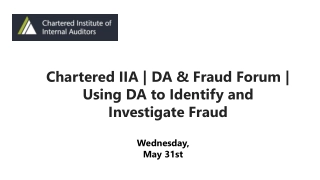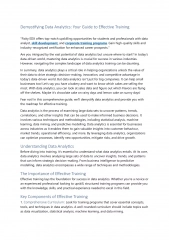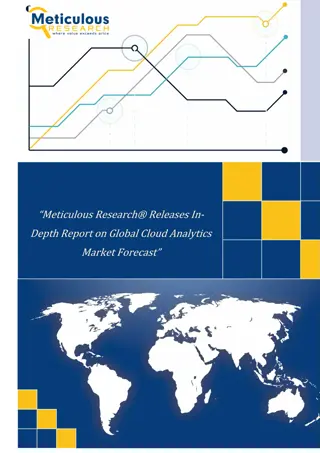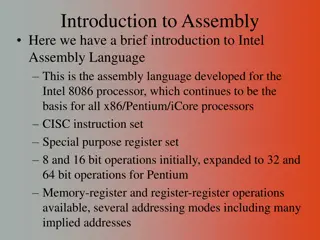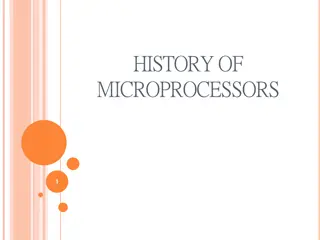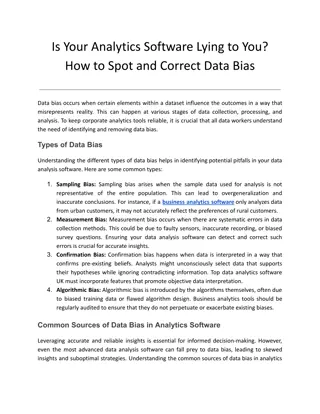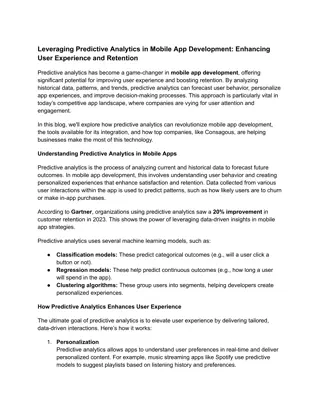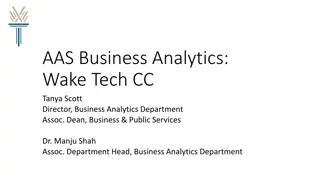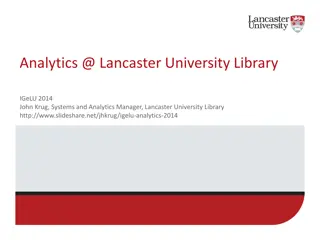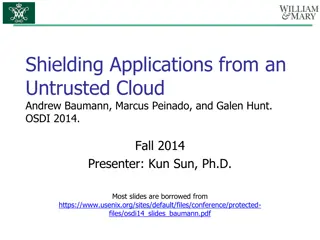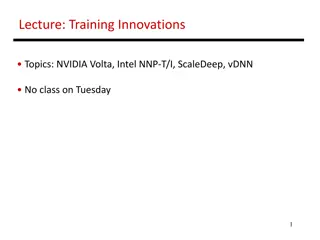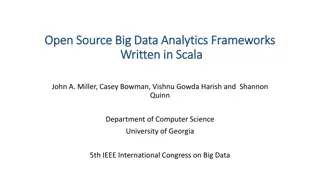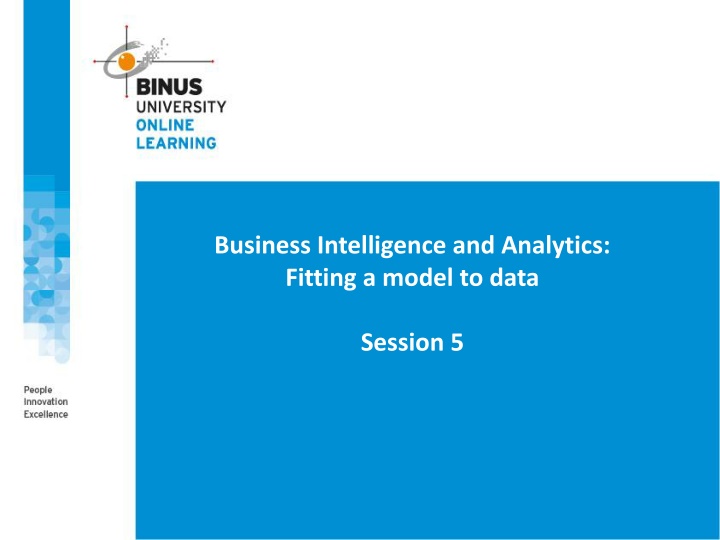
Fitting a Model to Data: Linear Classifiers and Discriminant Functions
Explore the concepts of fitting a model to data using linear classifiers like linear regression and logistic regression, and linear discriminant functions. Learn about simplifying assumptions for classification, agenda topics such as tree induction vs. logistic regression, and the instance-space view in linear classifiers. Gain insights into supervised segmentation and mathematical functions in data mining for model parameter tuning.
Download Presentation

Please find below an Image/Link to download the presentation.
The content on the website is provided AS IS for your information and personal use only. It may not be sold, licensed, or shared on other websites without obtaining consent from the author. If you encounter any issues during the download, it is possible that the publisher has removed the file from their server.
You are allowed to download the files provided on this website for personal or commercial use, subject to the condition that they are used lawfully. All files are the property of their respective owners.
The content on the website is provided AS IS for your information and personal use only. It may not be sold, licensed, or shared on other websites without obtaining consent from the author.
E N D
Presentation Transcript
Business Intelligence and Analytics: Fitting a model to data Session 5
Introduction So far: we produced both the structure of the model (the particular tree model) and the numeric parameters of the model from the data Now: we specify the structure of the model, but leave certain numeric parameters unspecified Data Mining calculates the best parameter values given a particular set of training data The form of the model and the attributes is specified The goal of DM is to tune the parameters so that the model fits the data as well as possible (parameter learning)
Simplifying assumptions For classification and class probability estimation, we will consider only binary classes. We assume that all attributes are numeric. We ignore the need to normalize numeric measurements to a common scale see data preparation
Agenda Linear classifiers Linear regression Logistic regression Example: tree induction vs. logistic regression
Linear classifiers (1/2) Instance-space view: shows the space broken up into regions by decision boundaries Examples in each space should have similar values for the target variable Homogeneous regions help predicting the target variable of a new, unseen instance We can separate the instance almost perfectly (by class) if we are allowed to introduce a boundary that is still a straight line, but is not perpendicular to the axes Linear classifier
Linear discriminant functions (1/2) Equation of a line:? = ?? + ? with m being the slope and b the y intercept Line in figure on slide 7: ??? = 1.5 ??????? + 60 Wewouldclassifyaninstance above the line, and as a if it is below the line. Mathematically: as a + if it is Linear discriminant discriminates between the classes Supervised segmentation by creating a mathematical function of multiple attributes A linear discriminant function is a numeric classification model, which can be written as
Linear discriminant functions (2/2) Fit parameters ?? to a particular data set Find a good set of weights w.r.t. to the features Weights may be interpreted as importance indicators The larger the magnitude of a weight, the more important What is the best line to separate the classes?
Optimizing an objective function What should be our objective in choosing the parameters? What weights should we choose? We need to define an objective function that represents our goal sufficiently Optimal solution is found by minimizing or maximizing Creating an objective function that matches the true goal of DM is usually impossible We will consider Support Vector Machines Linear regression Logistic regression 10
Mining a linear discriminant for the Iris data set
Linear discriminant functions for scoring and ranking instances Sometimes, we want some notion of which examples more or less likely to belong to a class Which customers are most likely to respond to this offer? Remember class membership probability Sometimes, we don t need a precise probability estimate a ranking is sufficient Linear discriminant functions provide rankings f(x) will be small when x is near the boundary f(x) gives an intuitively satisfying ranking of the instances by their (estimated) likelihood of belonging to the class of interest
An intuitive approach to Support Vector Machines (1/2) Support Vector Machines (SVM) are linear discriminants Classify instances based on a linear function of the features Objective function based on a simple idea: maximize the margin Fit the fattest bar between the classes Once the widest bar is found, the linear discriminant will be the center line through the bar The margin-maximizing boundary gives the maximal leeway for classifying new points
An intuitive approach to Support Vector Machines (2/2) How to handle data points that are misclassified by the model, i.e., if there is no perfect separating line? In the objective function, a training point is penalized for being on the wrong side of the decision boundary If the data are linearly separable, no penalty is incurred and the margin is simply maximized If the data are not linearly separable, the best fit is some balance between a fat margin and a low total error penalty The penalty is proportional to the distance from the decision boundary
Agenda Linear classifiers Linear regression Logistic regression Example: tree induction vs. logistic regression
Linear regression (1/2) Remember Which objective function should we use to optimize a model s fit to the data? Most common choice: how far away are the estimated values from the true values of the training data? Minimize the error of the fitted model, i.e., minimize the distance between estimated values and true values! Regression procedures choose the model that fits the data best w.r.t. the sum of errors Sum of absolute errors Sum of squared errors Standard linear regression is convenient (mathematically)!
Linear regression (2/2) Linear regressions minimizes the squarred error Squared error strongly penalizes large errors Squared error is very sensitive to the data erroneous or outlying data points can severely skew the resulting linear function For systems that build and apply models automatically, modeling needs to be much more robust Choose the objective function to optimize with the ultimate business application in mind
Agenda Linear classifiers Linear regression Logistic regression Example: tree induction vs. logistic regression
Logistic regression (1/5) For many applications, we would like to estimate the probability that a new instance belongs to the class of interest Fraud detection: where is the company s monetary loss expected to be the highest? Select different objective function to give accurate estimates of class probability Well calibrated and discriminative Recall: an instance being further from the separating boundary leads to a higher probability of being in one class or the other, and f(x) gives the distance from the separating boundary But a probability should range from zero to one!
Logistic regression (2/5) The likelihood of an event can expressed by odds The odds of an event is the ratio of the probability of the event occurring to the probability of the event not occurring Log-odds convert the scale to to + Probability Odds Correspondinglog-odds 0.5 50:50 or1 0 0.9 90:10 or9 2.19 0.999 999:1 or999 6.9 0.01 1:99 or 0.0101 -4.6 0.001 1:999 or0.001001 -6.9 Logistic regression model: f(x) is used as a measure of the log-odds of the event of interest f(x) is a an estimation of the log-odds that x belongs to the positive class 20
Logistic regression (3/5) How to translate log-odds into the probability of
Logistic regression (5/5) What does the objective function look like? Ideally, any positive example x+would have andanynegativeexample x wouldhave Probabilities are never pure when real-world data is considered Compute the likelihood of a particular labeled example given a set of parameters w that produces class probability estimates The g function gives the model s estimated probability of Seeing x s actual class given x s features For different parameterized models, sum the values across all examples in a labeled data set
Class labels and probabilities Distinguishbetweentargetvariableandprobability ofclassmembership! Onemaybetemptedthatthetargetvariableisarepresentationofthe probabilityofclassmembership Thisisnotconsistentwithhowlogisticregressionmodelsareused Example:probabilityofresponding ? (c responds)=0.02 Customer c actually responded,butprobabilityisnot 1,0! Thecustomerjusthappenedtorespondthis time. Training data are statistical draws from the underlyingprobabilities ratherthanrepresentingtheunderlyingprobabilitiesthemselves Logisticregressiontriestoestimatetheprobabilitieswithalinear-log-oddsmodel basedontheobserveddata
Agenda Linear classifiers Linear regression Logistic regression Example: tree induction vs. logistic regression
Example: Tree induction vs. logistic regression (1/4) Important differences between trees and linear classifiers A classification tree uses decision boundaries that are perpendicular to the instance-space axes. The linear classifier can use decision boundaries of any direction or orientation A classification tree is a is a piecewise classifier that segments the instance space recursively cut in arbitrarily small regions possible. The linear classifier places a single decision surface through the entire space. Which of these characteristics are a better match to a given data set?
Example: Tree induction vs. logistic regression (2/4) Consider the background of the stakeholders A decision tree may be considerably more understandable to someone without a strong background in statistics Data Mining team does not have the ultimate say how models are used or implemented! Example: Wisconsin Breast Cancer Dataset http://archive.ics.uci.edu/ml/datasets/Breast+Cancer+Wisconsin+(Diagnostic) Each record describes characteristics of a cell nuclei image, which has been labeled as either benign or malignant (cancerous) FromMu etal. (2011) doi:10.1038/ncomms1332 Ten fundamental characteristics were extracted and summarized in a mean (_mean), standard error (_SE) and mean of the three largest values (_worst) 30 measured attributes 357 benign images and 212 malignant images
Example: Tree induction vs. logistic regression (3/4) Results of logistic regression Weights of linear model Ordered from highest to lowest Performance: only six mistakes on the entire dataset, accuracy 98.9% Attribute Weight Smoothness_worst 22.30 Concave_mean 19.47 Concave_worst 11.68 Symmetry_worst 4.99 Concavity_worst 2.86 Comparison with classification tree from same dataset Weka s J48 implementation 25 nodes with 13 leaf nodes Accuracy: 99.1% Concavity_mean 2.34 Radius_worst 0.25 T exture_worst 0.13 Area_SE 0.06 T exture_mean 0.03 T exture_SE -0.29 Are these good models? How confident should we be in this evaluation? Compactness_mean -7.10 Compactness_SE 0 (intercept) -27.87 -17.70
Conclusion This Session introduced a second type of predictive modeling technique called function fitting or parametric modeling. In this case the model is a partially specified equation: a numeric function of the data attributes, with some unspecified numeric parameters. The task of the data mining procedure is to fit the model to the data by finding the best set of parameters, in some sense of best.
References Provost, F.; Fawcett, T.: Data Science for Business; Fundamental Principles of Data Mining and Data- Analytic Thinking. O Reilly, CA 95472, 2013. Michael R. Berthold, Christian Borgelt, Frank H ppner, Frank Klawonn, Guide to Intelligent Data Analysis, Springer-Verlag London Limited, 2010 Carlo Vecellis, Business Intelligence, John Wiley & Sons, 2009 Eibe Frank, Mark A. Hall, and Ian H. Witten : The Weka Workbench, M Morgan Kaufman Elsevier, 2016.

